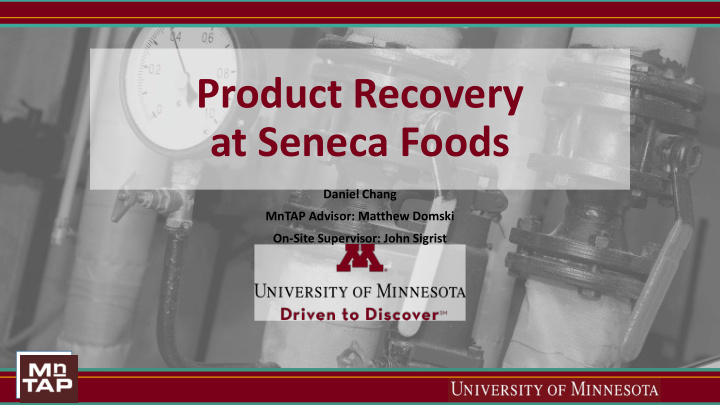



Product Recovery at Seneca Foods Daniel Chang MnTAP Advisor: Matthew Domski On-Site Supervisor: John Sigrist
Company Background • One of the leading producers of packaged produce in North America • 24 Plants in the East, West, and Midwest • Rochester plant operates seasonally
Motivations for Change • Recovery Program • Started in 2016 • Reducing product loss across production process • Not only Rochester, but for plants across Minnesota and Wisconsin • During full-operation, over 2,000 cans per minute are produced!
Reasons for MnTAP Assistance • Focus on reducing solid waste in Food Manufacturing • Improving recovery boosts efficiency of: • Water usage • Chemical usage • Electrical demand • Labor • Silage waste management
Process Description – Canned Peas • Receiving • Cleaning • Preparation • Fill and Close • Processing
Approach Primary question: “Where are we losing peas?” -Daniel Chang, 2017
CLEANING Receiving Air Foam RECEIVING Scalpers PREPARATION Cleaners Washers
PREPARATION Dock Blancher CLEANING Color Sorters Canned Peas FILL & CLOSE PROCESSING West Factory Blancher (Frozen Peas)
Approach – Pea Waste Checks • Sample waste streams every hour • Measure total sample weight and weight of defective (or good) product • Determine: • Efficiency (Weight % Good Peas) FILL & CLOSE • Pounds per hour of Good Peas Lost • Cost per hour of Good Peas Foam Color Sorters Air Cleaners Scalpers Air Cleaners Air Cleaners Washers
Fill & Close Peas Conveyor Belt Filler
Fill & Close Empty Cans Filled Cans (!!!)
Approach – Fill & Close • How much product is lost from falling out of the filler? • Determine hourly loss and cost
Results Efficiency of Separating Machinery Percentage in Waste Stream 100 90 80 70 60 Bad Peas 50 40 Good Peas 30 20 10 0 West Factory Receiving Air Foam Dock Blancher Scalpers Blancher Air Color Sorters Cleaners Washers Air Cleaners Cleaners
Results Loss Costs by Area $70,000 $60,000 $50,000 $40,000 $30,000 $20,000 $10,000 $0 West Factory Receiving Air Foam Dock Blancher FILL & Scalpers Blancher Air Color Sorters Cleaners Washers Air Cleaners CLOSE Cleaners
Recommendation – Color Sorters • [Continue to] use display monitors • Implemented this year at the start of the season • Allow daily communication of color sorter performance to mechanics for day-to-day adjustment • Cost: $10,000 • Results: • 33 tons of peas saved this season • $33,000 saved
Recommendation – Fill & Close • Add guide walls to contain product flow and prevent spills • Estimated 10% Reduction in Losses Waste Saved per Year Implementation Cost Savings per Year Payback Period Status 4.5 tons of peas $200 $4,500 Two Weeks Recommended • Replace shake pans with conveyor belts to return product into filler • Estimated 25% Reduction in Losses Waste Saved per Year Implementation Cost Savings per Year Payback Period Status 8 tons of peas $16,000 $8,000 Two Years Recommended
Recommendation – Defoamer • Chemical that is sprayed on top of water tanks to knockdown foam • Foam buildup results from starchiness of the peas • Causes water tanks to overflow • Challenges: • Inefficient use by workers • Current dosing system does not effectively control foam
Recommendation – Defoamer Et a l.… Pump Mix Tank Filled with Freezer Flume Pea Surge Dilute Water Water Receiving Hopper Defoamer Return Tank Return Tank Tanks 1-5 Return Tank One pumping system services over a dozen tanks through Blancher Sorter #4 Water Water several hundred feet of tubing Return Tank Return Tank across the plant
Recommendation – Defoamer • Prescribe training for workers • Estimated 50% reduction Waste Saved per Year Implementation Cost Savings per Year Payback Period Status 1,200 gallons None $7,000 Immediate Recommended • Upgrade dispensing system with an improved pump and new tubes • Estimated 25% reduction in usage Waste Saved per Year Implementation Cost Savings per Year Payback Period Status 600 gallons $7,000 $3,500 Two Years Recommended
Summary Implementation Savings per Payback Recommendation Waste Saved per Year Status Cost Year Period Continue Using Display Monitors 33 tons of peas $10,000 $33,000 Four Months Implemented Fill and Close Increase height of guard walls 4.5 tons of peas $200 $4,500 Two Weeks Recommended Add conveyor belts 8 tons of peas $16,000 $8,000 Two Years Recommended Defoamer Implement worker training 1,200 gallons of chemical None $7,000 Immediate Recommended Upgrade dispensing system 600 gallons of chemical $7,000 $3,500 Two Years Recommended Total Savings: 45 tons of peas, 1,800 gallons of defoamer, and $56,000 annually
Personal Takeaways • Vision • Importance of having a driven, improvement-oriented mindset • Recognizing problems and seeing solutions • Respect for complexity of industrial processes • Leadership through communication • Communication is a building tool • Involve others, especially those who will be directly affected by changes you want to make
Questions?
Recommend
More recommend